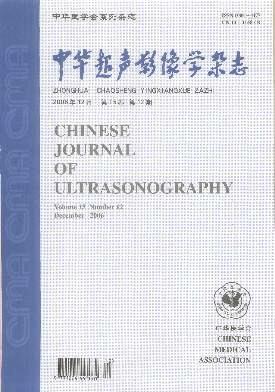Cerebroplacental blood flow redistribution in monochorionic-diamniotic twin pregnancies with selective fetal growth restriction
Q4 Medicine
引用次数: 0
Abstract
Objective To analyze the cerebroplacental blood flow distribution characteristics in monochorionic-diamniotic (MCDA) twin pregnancies with selective fetal growth restriction (sFGR), and investigate the relationship between co-twin cerebroplacental blood flow discordances and co-twin birth weight discordances (BWdisc). Methods The cerebroplacental blood flow distribution characteristics and their discordances were analyzed retrospectively in 52 MCDA twin pregnancies with normal growth (control group) and 52 with sFGR (case group), including the umbilical artery pulsatility index (UA-PI), middle cerebral artery peak systolic velocity (MCA-PSV), middle cerebral artery pulsatility index (MCA-PI), cerebroplacental ratio (CPR), and their discordances (UA-PIdisc, MCA-PSVdisc, MCA-PIdisc and CPRdisc). Results Compared to the control group, UA-PIdisc, MCA-PIdisc and CPRdisc increased significantly (all P<0.01). UA-PIdisc, MCA-PIdisc and CPRdisc were related positively to BWdisc as shown by correlation analyses (r=0.488, 0.414, 0.592; all P<0.001), and they had moderate predictive accuracy for sFGR with area under the curves of 0.743, 0.662 and 0.778, with sensitivity of 48.08%, 67.31% and 71.15%, and specificity of 92.31%, 59.62% and 78.85% (all P<0.01). Multivariate Logistic regression analyses showed that only CPRdisc were independently associated with sFGR (P<0.05). Conclusions More cerebroplacental blood flow discordances are observed in MCDA twin pregnancies with sFGR. Co-twin cerebroplacental blood flow discordance is related to BWdisc. Key words: Ultrasonography; Monochorionic-diamniotic twin; Selective growth restriction; Cerebroplacental ratio选择性胎儿生长受限单绒毛膜双羊膜双胎妊娠的脑胎盘血流再分布
目的分析选择性胎儿生长受限(sFGR)单绒毛膜双羊膜(MCDA)双胎妊娠的脑胎盘血流分布特征,探讨双胎脑胎盘血流不一致与双胎出生体重不一致(BWdisc)的关系。方法回顾性分析52例生长正常的MCDA双胎妊娠(对照组)和52例sFGR双胎妊娠(病例组)的脑胎盘血流分布特征及其不一致之处,包括脐动脉脉搏指数(UA-PI)、大脑中动脉收缩峰值速度(MCA-PSV)、大脑中动脉脉搏指数(MCA-PI)、脑胎盘比(CPR)及其不一致之处(UA-PIdisc、MCA-PSVdisc、MCA-PIdisc和CPRdisc)。结果与对照组比较,UA-PIdisc、MCA-PIdisc、CPRdisc均显著升高(P<0.01)。相关性分析显示,UA-PIdisc、MCA-PIdisc和CPRdisc与BWdisc呈正相关(r=0.488、0.414、0.592;曲线下面积分别为0.743、0.662和0.778,敏感性分别为48.08%、67.31%和71.15%,特异性分别为92.31%、59.62%和78.85% (P均<0.01)。多因素Logistic回归分析显示,只有CPRdisc与sFGR独立相关(P<0.05)。结论MCDA双胎合并sFGR存在更多的脑胎盘血流不一致。双胎脑胎盘血流失调与BWdisc有关。关键词:超声检查;Monochorionic-diamniotic双胞胎;选择性生长限制;Cerebroplacental比率
本文章由计算机程序翻译,如有差异,请以英文原文为准。
求助全文
约1分钟内获得全文
求助全文
来源期刊

中华超声影像学杂志
Medicine-Radiology, Nuclear Medicine and Imaging
CiteScore
0.80
自引率
0.00%
发文量
9126
期刊介绍:
 求助内容:
求助内容: 应助结果提醒方式:
应助结果提醒方式:


